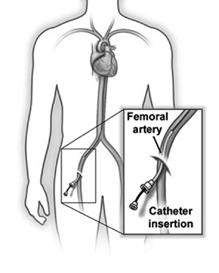Coronary Angiogram
What is Coronary Angiogram?
Coronary Angiogram is an X-ray study of your heart (coronary) vessels that involves the insertion of soft, tiny plastic tubes called a catheter, via the groin or wrist blood vessel.
The purpose of the study is to confirm the presence of Coronary Artery Disease (CAD) and to locate the exact site of blockage and its severity.
How is the procedure carried out?
Coronary angiogram is a largely pain-free procedure. Your doctor will administer local anaesthesia to numb the skin insertion site, which maybe on the groin or wrist.
A catheter is inserted through the blood vessel and advanced to the heart (coronary) blood vessel. The doctor will use the catheter to open the heart artery and inject a special “X-ray dye” called contrast through the catheter into the heart artery.
The contrast allows the doctor to visualise images of the heart arteries and/or heart chambers on the X-ray monitor. Any “blockage” of the heart artery (Figure 1) would reveal as a narrowing of the blood vessel.
After gaining access via your radial (Figure 2) or groin artery (Figure 3), the soft catheter is then advanced through the aorta to reach the opening of your heart artery and will be parked there.
Angiogram pictures will then be taken from different angles with multiple “dye” injections. You will notice that the X-ray tube would be turned around you in different directions.
 Blocked Artery
Blocked Artery
The doctor will communicate with you during the procedure as you will be awake.
The procedure usually takes around 20 to 30 minutes to complete.
Preparation before the test
• No specific preparation unless otherwise informed
• No fasting is required
• Take your medication as per normal
You may feel:
1. Slight pressure as the catheter is inserted.
2. Slight burning sensation over the chest region when dye is injected through the catheter.

What happens after that?
1. The catheter will be removed.
2. A nurse will apply direct pressure where the catheter was inserted for 15-30minutes to stop bleeding from the punctured artery.

3. A pressure dressing will be applied after the manual compression.
4. You will be sent back to your ward.
5. You will feel slightly sore where the catheter was inserted or from lying on your back. You will be asked to lie flat for 4-6 hours after your procedure if puncture site is on your groin.
6. Please alert the nurse if your arms or legs feel cold, numb or painful.
7. If you need to cough or sneeze, gently press on the puncture site before doing so (applicable to groin puncture site only).
Figure 2: Radial approach Radial artery Radial artery Figure 3: Femoral ApproachPotential (rare) risks with Coronary Angiogram
1. Vascular injury/bleeding
Injury to the blood vessel or bleeding may occur (1-2% of cases).
2. Contrast-related issues
Some patients may develop an allergic reaction to the contrast (dye) used. Kidney dysfunction is a known potential complication from contrast exposure. The risks may be higher if you already have kidney disease but your doctor will give you preventive agents to protect your kidneys.
3. Infection
Infection at the incision site may occur.
4. Complications
Rare complications like stroke or death may occur (less than 1%).
Upon discharge
1. You may feel slight pain over the incision site but its intensity should not worsen.
2. It is common to have a bruise at the incision site. You may experience some soreness when walking but it will gradually subside.
3. You are able to bathe and do other activities as usual.
4. Please refrain from lifting heavy objects or engaging in strenuous exercise for 7 days after the procedure.
5. If there is increased swelling, gently compress on the incision site and refrain from putting excessive pressure on the affected limb.
6. Do not use lotion, cream or ointment on the incision site.
Pointers to note:
1. You should arrange for a relative or friend to fetch you home.
2. You are discouraged from driving home on your own.
3. You are advised to keep your follow-up appointment with your doctor.
You should seek medical help if:
1. The incision site is increasing painful, swollen, red or bleeding.
2. There is discharge from the incision site or you develop fever (>38 oC).
3. Unusual bleeding (e.g. blood in your urine or black stools).
If you encounter any of the above, please call us at 6602 3954 (between 8.30am to 5.30pm), or visit our emergency department after office hours.
Supplementary information
Scan the QR code to view the patient education video, available in four languages.


